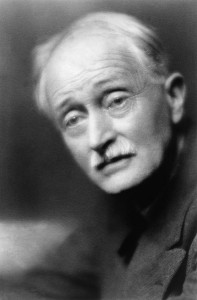 Born in Herefordshire, England, in 1878, John Masefield is probably one of the most often quoted British poets of the 20th century. His mother and father both died when he was young, which left him under the charge of a domineering aunt. Although he exhibited a talent for writing from an early age, his aunt enrolled him, against his wishes, into the merchant navy. In 1895 he docked in New York, resigned and did not return to England for the next two years.
Born in Herefordshire, England, in 1878, John Masefield is probably one of the most often quoted British poets of the 20th century. His mother and father both died when he was young, which left him under the charge of a domineering aunt. Although he exhibited a talent for writing from an early age, his aunt enrolled him, against his wishes, into the merchant navy. In 1895 he docked in New York, resigned and did not return to England for the next two years.
Instead, he resolved to dedicate himself to writing poetry, a vocation that appealed to him after he picked up a copy of a New York magazine and found a poem by Duncan Campbell Scott. Masefield worked in a carpet factory but during his spare time read voraciously; everything from Dumas, Dickens and Kipling to Chaucer. He returned home to England, married and set about writing. He was published in several journals in those early years and finally published his first collection of works in 1902 at the age of just 24.
Salt Water Ballads contained perhaps one of his most well-known earlier works, Sea Fever. For a while after its publication, he started to write novels and published two over the next decade with moderate success. A return to poetry however saw him garner greater recognition with his narrative poem The Everlasting Mercy which, along with two other poems, led to him being given the Edmond de Polignac Prize in 1912.

Although he was old enough to not be called up for active duty at the outbreak of war in 1914, Masefield joined a British medical unit, working as an orderly. His time near the fighting led to a number of war poems, the best of which is August 1914. He was later recruited by the Department of Information and went to America, hoping to gauge whether they were likely to enter the war in Europe. At the time he also wrote a number of books such as Gallipoli and a later one The Somme. He returned once again to America in 1918 to lecture and speak to American troops who were preparing to move out to Europe to fight.
After the war, Masefield and his family settled in Oxford where he cemented his reputation as one of the most respected writers of the day. Of the three poems he wrote in the early Twenties, perhaps Reynard the Fox is the best known but all received good reviews and his Collected Poems in 1923 sold over 80,000 copies. Masefield turned away from poetry again after this, publishing 12 novels over the next 15 years until the start of World War II.

In 1930 Masefield became the new Poet Laureate after the death of Robert Bridges. It was a role Masefield would carry out diligently for the next 37 years and he produced a number of poems during that time. He was also awarded the Order of Merit by King George V and used his new position to promote and encourage writing and poetry, particularly with the introduction of Royal Medals for Poetry.
In his seventies, his wife Constance died after a long illness but he continued to fulfill his role as Poet Laureate. At the age of 88, he developed an infection due to gangrene and he died in May 1967, his ashes scattered in Poet’s Corner.

